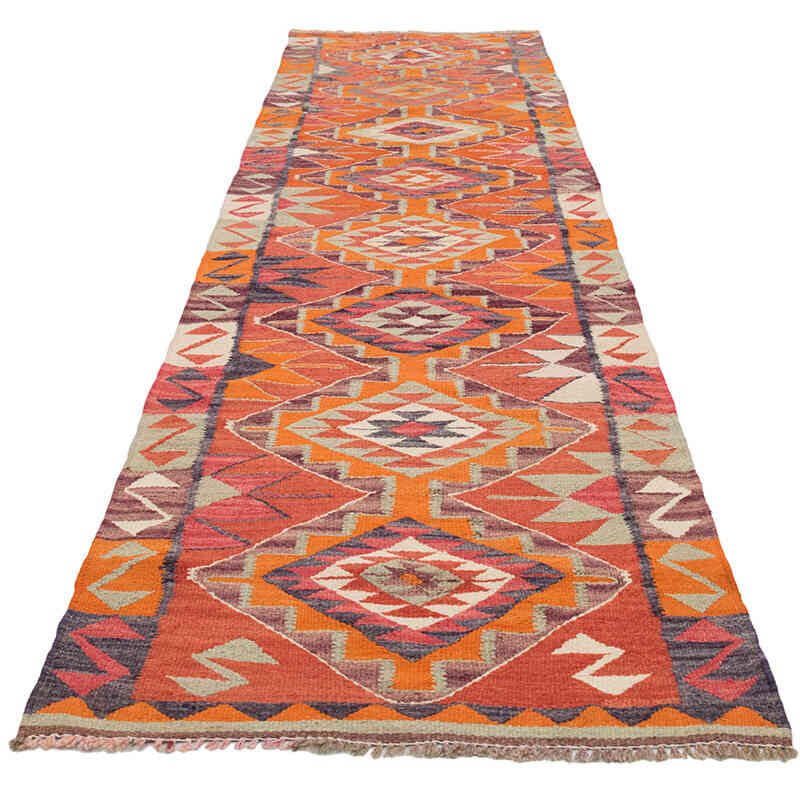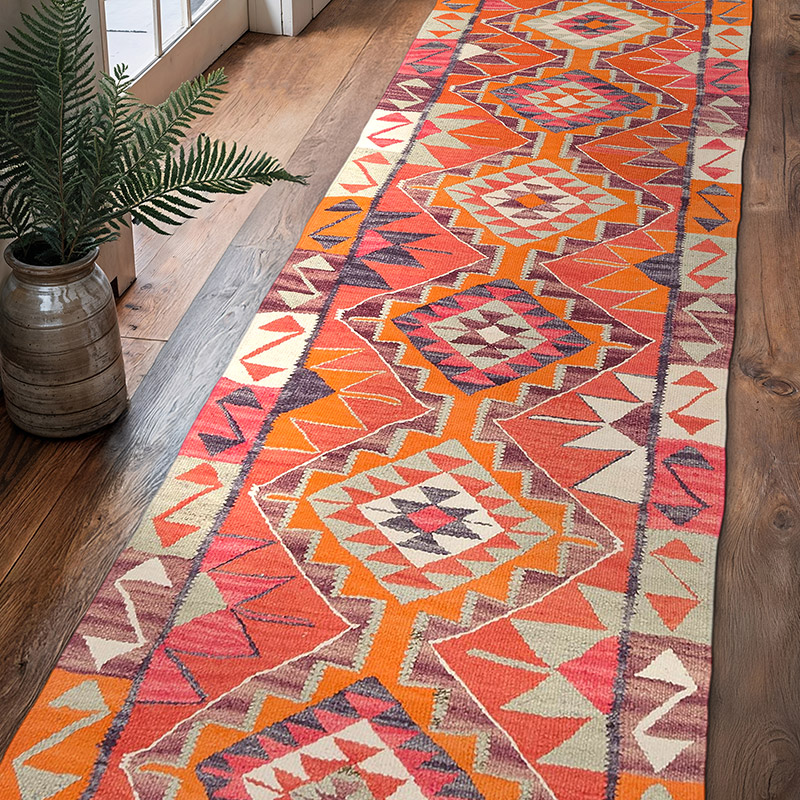Vintage Tribal Kilim Runner 3' 1" x 10' 8" (37" x 128")
Type:
Kilim RugsCollection:
Tribal Runners, ClearanceID:
K0077129Size:
Material:
The designs feature a rich array of symbols representing tribal culture and Anatolian motifs, often in the form of medallions, diamonds, and other geometric shapes.
The designs feature a rich array of symbols representing tribal culture and Anatolian motifs, often in the form of medallions, diamonds, and other geometric shapes. These kilim runners are ideal for hallways and narrow spaces, offering a touch of ethnic charm and artisanal quality to any interior.
Herki kilims not only serve as functional floor coverings but also as artistic expressions of tribal identity, making each rug a unique cultural artifact.
Design Elements
- Patterns: The vintage tribal kilim runner features geometric shapes and symmetrical arrangements, common in kilim designs. The abstract motifs include diamonds, circles, and zigzag lines which create a rhythmic flow throughout the rug.
- Texture: Crafted using traditional weaving techniques, the texture is flat and sturdy, characteristic of kilim rugs. The handwoven nature imparts a unique pattern variation, enhancing its charm and authenticity.
- Orientation: The design is elongated and meant for narrow spaces, making it ideal for hallways or entryways. The pattern flows vertically, guiding the eye along the length of the runner.
- Symmetry: The layout shows a sense of balance and order. Repetition of motifs on either side brings a harmonious aesthetic and creates a focal point.
Colors
- Red and Orange: Dominant colors in the runner represent warmth and vibrancy. They evoke emotions of passion, love, and energy.
- Earth Tones: Shades of beige, brown, and muted colors represent a connection to nature, grounding the design and providing contrast to the vibrant hues.
- Contrasting Tones: The use of darker colors like maroon against lighter shades enhances the overall visual appeal, creating depth and dimension in the design.
- Harmonious Palette: The interplay of warm and neutral tones creates a cohesive look that allows the rug to easily complement various interior styles.
Main Motifs and Their Symbolism
- Diamond Motif: Often symbolizes wealth and prosperity. In tribal cultures, it represents the path of life and the journey between earthly existence and the divine.
- Eye Symbol: Typically represents protection against evil spirits. It serves as a talisman to ward off negativity and bring good luck to the home.
- Zigzag Patterns: Reflect the cycles of life and nature, symbolizing water and fertility. It can also represent mountains, symbolizing strength and endurance.
- Color Blocking: The bold delineation of colors adds dynamism and energy, symbolizing the vibrancy of life, tradition, and the cultural heritage of the weavers.
Summary
The vintage tribal kilim runner showcases a mesmerizing array of geometric patterns and a vibrant color palette. The design elements include intricate motifs, a harmonious balance of symmetry, and a flat texture. The primary colors of red and orange imbue it with warmth, while earth tones add grounding contrasts. Significant symbols like diamonds, eyes, and zigzag patterns convey themes of prosperity, protection, and life's cycles, reflecting the rich cultural narratives of tribal heritage.
- Ships in 1-4 business days
- Only one in stock, handmade, unique
- Free shipping via FedEx Express. Easy returns
- Contact us or add a note to your order if you want us to delay your shipping.
- Request more info if you want this rug shorter or narrower
Colors may appear slightly different across various monitors due to screen settings device differences, and external lighting conditions. If color accuracy is important for your space, we recommend viewing the rug on multiple devices or contacting us for a detailed color description. We can provide detailed photos and references using Sherwin-Williams, Benjamin Moore, Pantone, or even Crayola crayons.
You can also visualize most of our products in your own room with AR (augmented reality) on an iPhone or iPad.
Return Policy
Need a rug pad? We recommend RugPadUSA























Thank you for your high level of…